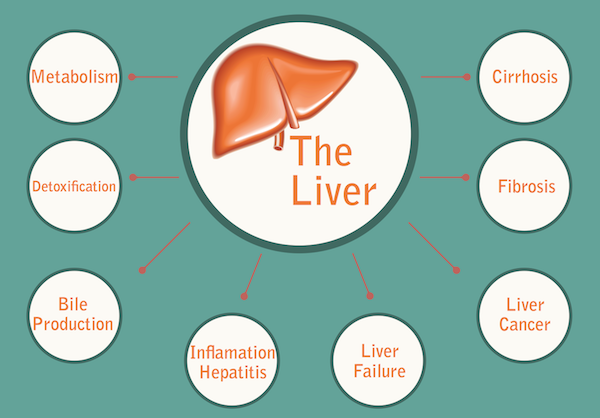Most people are unaware of the range of critical functions performed by the all-important body’s organ, the liver. Unfortunately, liver disease today is increasing due to alcohol use, obesity, viruses, and a range of other factors. In fact, approximately 5.5 million Americans now have chronic liver disease known as severe liver scarring or cirrhosis (alcoholic and non-alcoholic/fatty livers).
Mayo Clinic (February 2018 Newsletter) explains, “Your body can’t function without a working liver, and cirrhosis can have serious complications that negatively impact quality of life and longevity.”

In my 2 Part Series, let’s become educated seniors and learn all about the liver and how to keep this major organ healthy.
Weighing in at approximately 2 to 3 pounds, the liver is the body’s largest, solid internal organ. It is the size of a football. This multilobed organ sits on the right side of the abdomen under the rib cage. It typically takes the shape of your body: long and lean or squat and square. Mayo states, “Like a complex processing plant, its specialized cells play a key role in maintaining your health.”
1. METABOLISM: (a. THE LIVER regulates blood sugar levels. (b. It changes fats into energy and other forms to be used by your cells. (c. It produces and manages cholesterol by converting it into bile acids and then removing the cholesterol from the body. (d. It forms proteins, some of which are used in cleaning the blood and forming clots. (e. It metabolizes hormones such as cortisol and estrogen. (f. It stores minerals, including iron, along with vitamins.
2. DETOXIFICATION: THE LIVER cleans potentially dangerous substances from your blood as it works as a large filter (as in misuse of medications). It even has specialized cells to ingest and destroy invading bacteria, their viruses, and toxins.
3. BILE PRODUCTION: With 2 cups of bile produced daily, this yellow-green soapy liquid breaks down fats for further digestion. Stored mostly in the gall bladder, bile is excreted into the small intestine during meal time. The liquid is a major contributor to body waste removal.
Unfortunately, many signs of our progressive damaging of the organ are not specific to liver disease alone. The varied symptoms may be fatigue, weakness, loss of weight and appetite, nausea, intense itching, muscle cramps, yellow discoloration of the skin or eyes (jaundice), abdominal discomfort or swelling, edema or swelling in the legs, stool changes in color, spiderlike blood vessels on chest and arms, vomiting blood in different colors, redness in the palm of the hands, confusion-drowsiness-slurred speech, and increased side effects from meds due to trouble in metabolizing them. Therefore, liver damage is often delayed in being discovered, not until an annual physical or when other health problems are being checked out. In many cases, damage has already been done.
Here are the progressive diseases that indicate liver damage.
1. INFLAMATION/HEPATITIS: Here, the liver is trying to fight an infection or heal an injury. Removal of the substance causing the damage is necessary.
2. FIBROSIS: Untreated inflammation, can lead to scarring of the organ as it tries to heal itself. Early treatment is vital.
3. CIRRHOSIS: This is when scar tissue can’t heal itself. The liver loses its ability to perform its complex jobs. Even this advanced stage of liver disease can be reversed (often over a period of time) if treated properly.
4. LIVER CANCER: Patients with cirrhosis have a much greater chance of developing this form of cancer as their primary site. The rate of this form of cancer has more than tripled since 1980, according to Mayo’s newsletter. Approximately 30,000 new cases are being diagnosed yearly in the U.S. The clinic continues “Liver cancer has a poor prognosis – less than 20 percent of people diagnosed with the most common form remain alive after 5 years.”
5. LIVER FAILURE: This occurs when the liver is losing or has lost all its ability to work proficiently. Chronic failure occurs over a period of time. Acute or sudden failure can be the result of medication overdose, chemical toxicity, a blood infection (sepsis), viral infections, and shock. This liver failure must be treated at once.
Part 2: Diagnosis of Disease, Treating Liver Problems, Transplants and Research



